
Asus CrossHair II Formula
Manufacturer: AsusUK Price (as reviewed): £148.21 (inc. VAT)
US Price (as reviewed): $274.99 (ex. Tax)
Introduction
Eighteen months ago we reviewed Asus' original CrossHair based on Nvidia's nForce 590 SLI chipset for AM2 Athlon 64 CPUs. The layout of that board was, well, interesting, but the features set a new record in terms of awesomeness.Things have come a long way since then; since the time when Athlons were the talk of the town, Intel chips were simply used as space heaters in the world of the enthusiast. Now we have the opposite situation, where Phenoms are playing second fiddle to Intel's Core 2, although the features Nvidia brings to the table with this particular motherboard does perk an interest, that's for sure.
The board is built around the latest "enthusiast" nForce 780a SLI MCP chipset that also includes Hybrid SLI graphics which you won't find on Intel platforms until the third quarter, according to hints from CEO Jen-Hsun Huang during the recent earnings call.
The CrossHair II includes the Formula moniker all DDR2 boards have, even when you don't currently have a choice with AMD CPUs. It has been suitably updated from its brethren, even if the box remains the same. Its layout is greatly improved and its features are better kitted to match more recent Republic of Gamer advances, without getting too stupid.
Unfortunately given the continual spate of product releases from Nvidia the nForce 780a SLI MCP has been largely overshadowed. Hailed as the saving grace for the planet and making all things efficient in a massive hoo-har Nvidia created earlier this year at CES, it landed to driver and BIOS problems and very few products hit the shelves. Coupled with very few 9-series cards available at the time (only the 9-series has the suitable hardware to support it), it seemed like a very expensive investment for a platform that no one wanted to buy into.
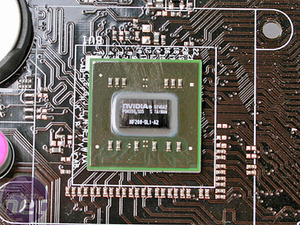
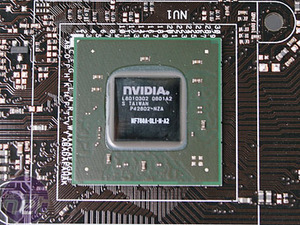
The Nvidia NF200 (you'll be seeing a lot more of this in its A3 revision, in the coming months) and the nForce 780a chipset. Click to enlarge
Time has given us massive price drops for the 9800 GTX thanks to some much needed competition from AMD, and new cards like the GTX 280, GTX 260, 9800 GTX+, 9800 GT (wait, isn't this an 8800 GT? - yes, but it's been redesigned to support Hybrid SLI), which all support HybridPower, and the 9600 GSO, 9600 GT and 9500 GT, which don't support Hybrid SLI at all. During that time, there has also been the inevitable price drops and BIOS advancements from Asus for the CrossHair II Formula we're reviewing here.
Cynical criticisms aside, low end cards don't need to benefit from HybridPower - there's not a sufficient difference between the idle power with it on or off, however juice guzzling behemoths like the 9800 GX2 certainly benefit from having the option, while others like the new GeForce GTX 200-series don't really because idle power consumption is already impressive. The inexpensive 9500 GT doesn't have GeForce Boost like the 8500 GT did, but there's currently no 9-series option available unless Nvidia decide to rebrand the 8400 GS. All we're saying is that Nvidia has lost the naming plot - it's easier to decipher Enigma than it is to correlate Nvidia product naming to features these days.
Regardless, it should be the perfect time to review the nForce 780a SLI hardware - there's finally the necessary hardware breadth for purchasing choice, even if it is confusing as hell, and coupled with Asus' legendary Republic of Gamer series, this should make a winning combination, right?
Hybrid SLI
We wrote a massive Tim-depth piece on Hybrid SLI earlier this year, so if you want to grab the subject by the short and curlies and envelop yourself in everything there is to know about HybridPower and GeForce Boost from Nvidia, go here and here.Nvidia nForce 780a SLI MCP
The nForce 780a SLI MCP is actually a three part affair - firstly, the graphics core is a GeForce 8200. In fact, the chipset is basically a GeForce 8200 with its 500MHz core frequency, a 16 shader units running at 1.2GHz. There's also the PureVideo HD engine that supports all common video decoding acceleration, Picture in Picture, as well as 7.1 channel LPCM audio providing you fish out the right driver. Dual display is supported, but like AMD's solutions there's no support for dual digital outputs - this is partly why the CrossHair II Formula comes only with a HDMI and VGA connections, and includes HDMI to DVI adapter if you need it.In addition there are 12 USB 2.0, six SATA 3Gbps ports and a single IDE channel with RAID 0, 1, 0+1, 5 and JBOD, a few PCI-Express x1 and PCI slots, one Gigabit Ethernet MAC and 7.1 channel High-Definition audio. This is all in a single chip, remember.
But the Asus board has what looks like two? Well Nvidia bolts on the NF200 chip to give it either two full PCI-Express 2.0 x16 lanes or three way SLI with x16, x8, x8. Remove the NF200 and you have a 750a; take away the HybridPower option and we're back down to a basic GeForce 8200. Easy, eh?

MSI MPG Velox 100R Chassis Review
October 14 2021 | 15:04



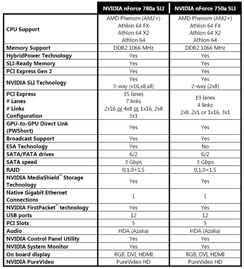
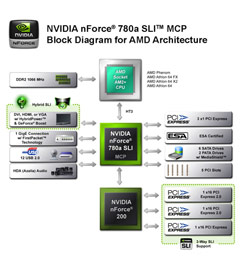
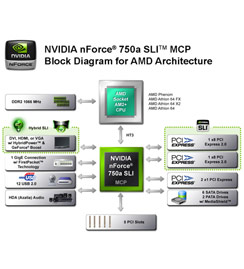







Want to comment? Please log in.